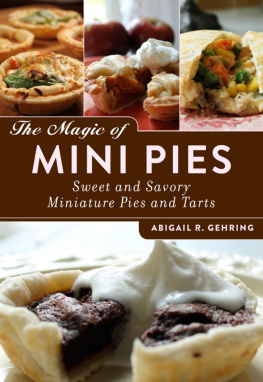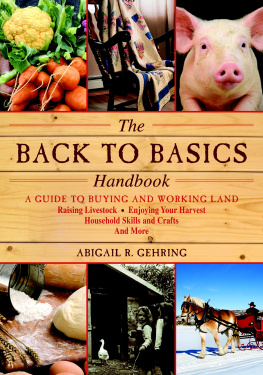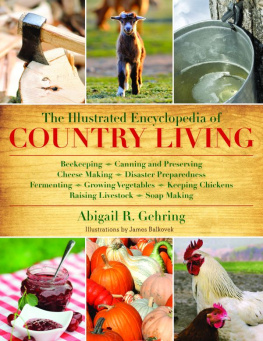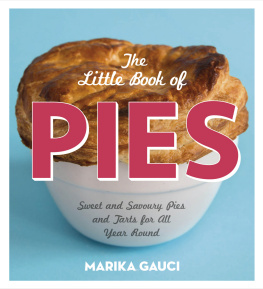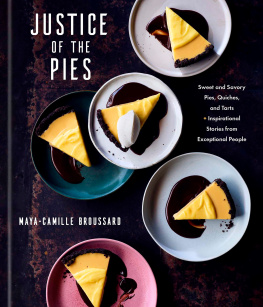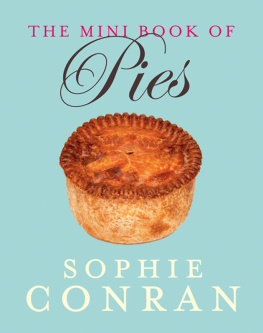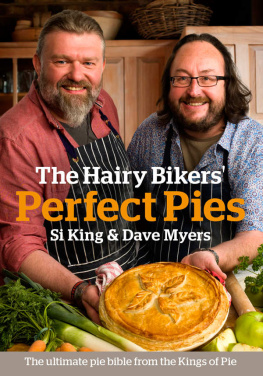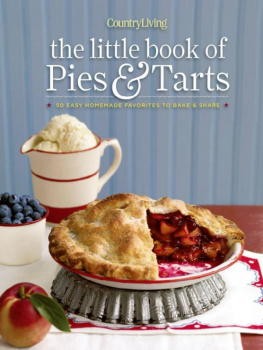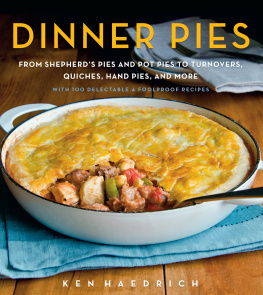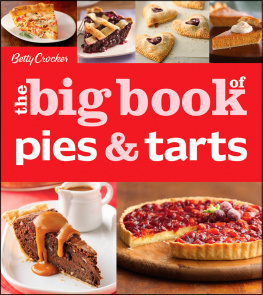The Magic of
MINI PIES
Sweet and Savory
Miniature Pies and Tarts

Copyright 2012 by Abigail R. Gehring
All Rights Reserved. No part of this book may be reproduced in any manner without the express written consent of the publisher, except in the case of brief excerpts in critical reviews or articles. All inquiries should be addressed to Skyhorse Publishing, 307 West 36th Street, 11th Floor, New York, NY 10018.
Skyhorse Publishing books may be purchased in bulk at special discounts for sales promotion, corporate gifts, fund-raising, or educational purposes. Special editions can also be created to specifications. For details, contact the Special Sales Department, Skyhorse Publishing, 307 West 36th Street, 11th Floor, New York, NY 10018 or .
Skyhorse and Skyhorse Publishing are registered trademarks of Skyhorse Publishing, Inc., a Delaware corporation.
Visit our website at www.skyhorsepublishing.com.
10 9 8 7 6 5 4 3 2 1
Library of Congress Cataloging-in-Publication Data is available on file.
ISBN: 978-1-62087-398-4
Printed in China
We must have a pie. Stress cannot exist in the presence of a pie.
David Mamet, Boston Marriage

{ CONTENTS }

{ INTRODUCTION }
E veryone loves piebut not everyone loves the same kind of pie. Our family has had Thanksgiving dinners with a dozen different big, beautiful pies, each with one or two slices missing at the end of the dayeveryone gets their favorite kind, but it takes days to prepare them all, and the amount of leftovers is downright shameful. Mini pies provide a delicious, sensible, and adorable alternative. They are quick to assemble and bake and allow you to customize your baking to your guests' (or your own) tastes. Make a little apple pie for your aunt, pumpkin for your dad, pecan for the neighbor, and one of each for yourself! (You can always freeze the extras for another day.)
Savory mini pies are perfect for hors d'oeuvres at a gathering or to make ahead of time, freeze, and bring to work for lunch. You can use the recipes in this book to start with and then experiment with your own variations. There are endless varieties of quiches, pizzas, and vegetable or meat pies you can make to satisfy any palateyou can even let kids help create their own individual pies!
What makes a sweeter care package than a few little pies made especially for your loved one? To ship mini fruit or nut pies (don't try shipping very perishable pies, such as meat or cream pies), allow them to cool thoroughly and then wrap each in parchment paper and then plastic wrap or aluminum foil. Freeze the pies overnight. Remove from freezer just before shipping. Find a sturdy cardboard box and cut two thick pieces of Styrofoam that will fit in the bottom of the box. Cut pie-sized holes in the second piece of Styrofoam to place the pies into. Cover with packing peanuts or crumpled newspapers and another layer of foam on top. Ship the pies over-night, if possible, and warn the recipient that something special is coming so the box doesn't end up sitting at the post office or on their back porch for days!
Whether you use a countertop mini pie maker appliance or bake your pies in muffin tins or small pie plates, you may need to experiment with amounts of filling and baking times to get the pies just right. The recipes in this book are geared for four mini pies made in a standard mini pie maker appliance or four pies made in a standard muffin tin.
Happy baking!
Abigail R. Gehring
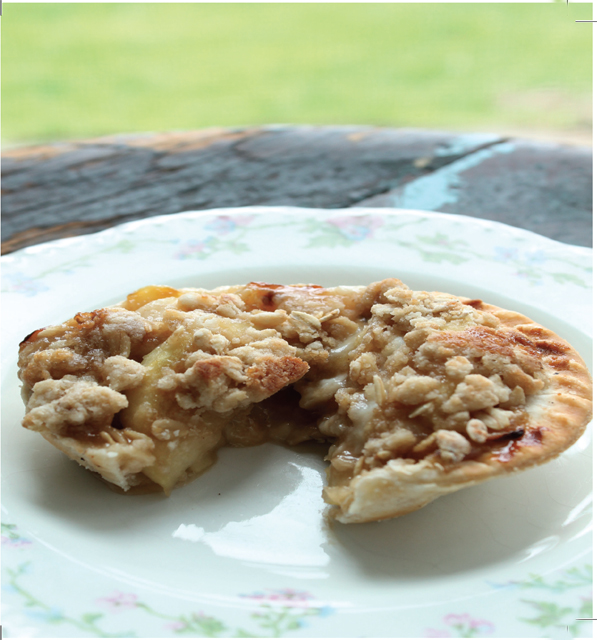
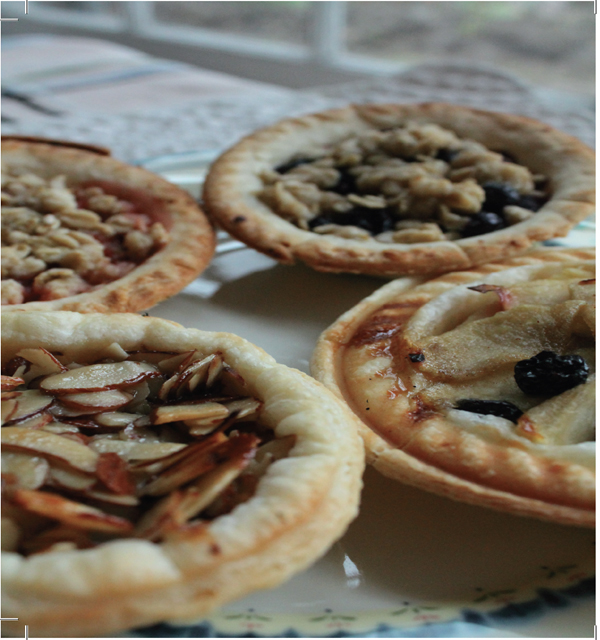
{ BAKING MINI PIES }
I f you're making mini pies in a countertop appliance, follow the manufacturer's instructions. Start by preheating the pie maker and cutting the dough with the provided dough cutter. Then place the bottom crust rounds over the four cups and fill each a little more than half way. Cover with the top crusts and close the lid to bake for the specified amount of time.
The instructions for your mini pie maker may tell you not to use gravies or custard fillings because too much liquid can make the bottom crusts soggy. I haven't had this problem, but if you do, add more cornstarch or flour to the filling or stick to fruit, nut, or savory fillings that are less liquidy.
The recipes in this book make enough for four mini pies in most standard mini pie maker appliances. If you wind up with extra filling, you can make more pies (most pies can be wrapped in plastic or foil and frozen), freeze the filling for later use, or even eat the filling on its own! If you want to make fewer than four pies, reduce all the ingredients proportionally. Most savory, fruit, and nut pies are fairly forgiving, meaning that if the proportions aren't exact, the pies will most likely still be delicious. Cream and custard pies are less forgiving; if you change the proportions you may end up with a pie that's not the right consistency.
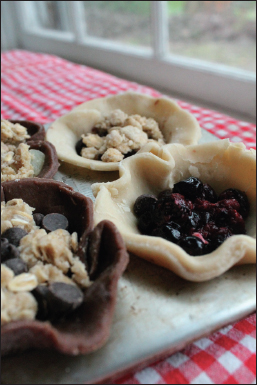
It's easy to make mini pies in muffin tins. The recipes in this book will make four mini pies in regular-sized muffin cups.
You can also bake mini pies in small pie plates or in muffin tins. Cut the dough in rounds that are large enough to cover the bottom and sides of the tin and to hang over the edge about inch. Press the dough round into the tin. The top rounds can be cut smaller. After you add the filling, place the top crust on and use a fork to seal and crimp the edges. In most cases, you'll need to bake pies in the oven for about 5 to 8 minutes longer than you would in a mini pie maker appliance, though this depends somewhat on the filling and the size of the pies. Pies are done when crusts are golden.
You may need to modify the recipes somewhat to get the right amount of filling, depending on how many pies you're making and what size the tins are. Most of the recipes in this book make about 2 cups of filling.
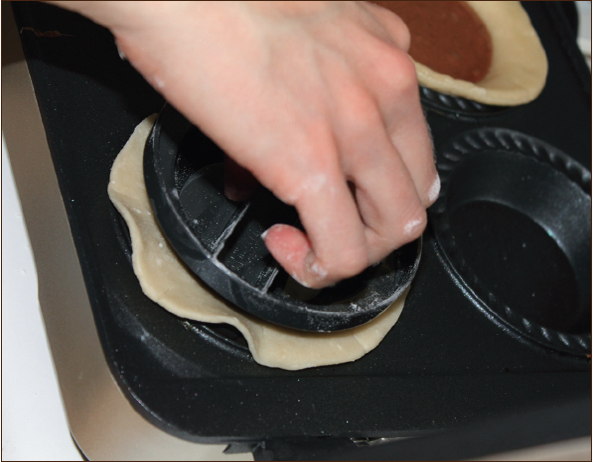
When using a mini pie maker appliance, press the dough down carefully to make an even indent, and then fill a little more than halfway with pie filling.
{ MAKING PIECRUST }
I t seems every baker has her favorite piecrust recipesome insist a combination of butter and lard makes for the flakiest crust, others use only vegetable oil, and still others only use the kind that comes pre--made in a neat roll from the supermarket shelf (a viable option, if you're in a hurry). I prefer homemade piecrust to the store-bought variety, mostly because I'm not comfortable with the ingredients used in most prepackaged piecrusts. For the same reason, I like to stick to butter (rather than using lard or shortening)I have no illusions about piecrust being healthy, but I'm convinced butter is a bit kinder to the body than hydrogenated fats or lard. Most any standard piecrust will work fine in your mini pie maker, but here I've included four of my preferred recipes (starting on ).

